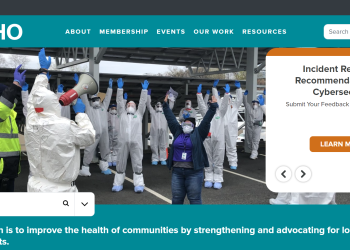By Alexandra Jabs, former Local Public Health Policy & Practice Scholar at NACCHO, and current Master in Public Health candidate at Johns Hopkins University Bloomberg School of Public Health and Juris Doctor candidate at the University of Maryland Francis King Carey School of Law
 Coordinated risk communication efforts are essential during all stages of emergency response efforts. This includes not only communications with the public but also communications between agencies involved in response efforts. However, a standardized approach to risk communication efforts during preparedness and response activities at local health departments does not exist at this time. Local health departments will benefit from a standardized approach to risk communications through improved internal coordination and dissemination of messages to their communities. Enhancing internal coordination and information sharing between responding agencies is necessary to provide a clear, unified message to the public. Furthermore, a standardized approach will help local health departments use evidence-based methods to effectively reach all populations within their community.
Coordinated risk communication efforts are essential during all stages of emergency response efforts. This includes not only communications with the public but also communications between agencies involved in response efforts. However, a standardized approach to risk communication efforts during preparedness and response activities at local health departments does not exist at this time. Local health departments will benefit from a standardized approach to risk communications through improved internal coordination and dissemination of messages to their communities. Enhancing internal coordination and information sharing between responding agencies is necessary to provide a clear, unified message to the public. Furthermore, a standardized approach will help local health departments use evidence-based methods to effectively reach all populations within their community.
The Institute of Medicine has designated the improvement of communications in preparedness and response as a research priority.[1] Specifically, research should concentrate on “(1) evaluating the characteristics of effective risk communication in pre-emergency and emergency settings, and (2) developing system enhancements to improve effective information exchange across diverse populations and entities in pre-emergency and emergency situations.”[2] Furthermore, the Centers for Disease Control and Prevention (CDC) has prioritized research on best practices and strategies to ensure timely and accurate communications to all affected populations, including vulnerable populations.[3] Nevertheless, a review of current literature revealed a dearth of relevant research as to evidence-based approaches.
Generally, risk communication research has focused on both internal information sharing among emergency response partners and external communications with the public. Although the literature suggests that information sharing, management, and technology “characterize” responding agencies’ ability to internally coordinate, there is no evidence of best practices for how to incorporate these characteristics into a scalable and standardized communications system.[4] With regards to external risk communication, building and strengthening relationships with the public and media outlets is integral to strengthening communications coordination and risk communication capacity. Additionally, health departments should pay specific attention to the diversity of the population they serve, as information uptake may not be equal among differing social groups.[5] For instance, studies have shown that low socioeconomic status is a barrier to information dissemination.[6] Yet there is little published evidence that exists about best practices to ensure that local health departments reach all of the populations they serve.[7]
Local health departments have varying levels of resources and operational requirements to meet the needs of their communities. The type and size of the population served can range from less than 25,000 to greater than 1,000,000; additionally, some local health departments work within a more centralized public health system while others are operate with greater independence. Moreover, many local health departments experienced recent funding cuts and NACCHO’s 2013 National Profile of Local Health Departments indicates that 41% of local health departments were subject to workforce reductions.[8] This impacts local health departments’ ability to prioritize risk communication capacity.[9] Only 32% of local health departments have a full-time public information specialist equivalent on staff.[10] It is likely that risk communication activities often fall to staff whose primary responsibilities are not related to communications or that communications staff are shared among several local municipal entities, as less than 20% of the nation’s 2,800 local health departments have a full-time communications professional on staff.[11] Yet these factors should not preclude the development of a scalable standardized approach to risk communications.
Resources for more closely aligning risk communication capacity at local health departments with federal preparedness guidelines are available. The CDC has issued guidelines regarding preparedness capacity in The Public Health Preparedness Capabilities: National Standards for State and Local Planning. Specifically, Public Health Preparedness (PHEP) Capability 4: Emergency Public Information and Warning and PHEP Capability 6: Information Sharing inform risk communication capacity standards for local health departments. NACCHO has compiled resources and trainings for local health departments to address the PHEP capabilities in its Resource Portfolio Project on the CDC Public Health Preparedness Capabilities. Furthermore, research has indicated that strengthening ties between local health departments nationally may foster the development and adoption of evidence-based strategies by local health departments.[12] Therefore, strengthening risk communications capacity as well as developing relationships with and learning from other local health departments may help with the development of a standardized approach, allowing local health departments to better serve their communities.
- Institute of Medicine of the National Academies. (2008). Research Priorities in Emergency Preparedness and Response for Public Health Systems: A Letter Report. Retrieved on February 11, 2015, from http://www.nap.edu/catalog/12136/research-priorities-in-emergency-preparedness-and-response-for-public-health-systems.
- Ibid.
- Centers for Disease Control and Prevention. (December 2006). Advancing the Nation’s Health: A Guide to Public Health Research Needs, 2006-2015. Retrieved on February 6, 2015 from stacks.cdc.gov/view/cdc/11428/cdc_11428_DS1.pdf.
- Savoia et al. (March 2009). Public Health Systems Research in Emergency Preparedness: A Review of the Literature. American Journal of Preventive Medicine, 37(2). Retrieved on December 5, 2014, from http://www.ncbi.nlm.nih.gov/pubmed/19524394.
- Ibid.
- Lin et al. (November/December 2014). Media Use and Communication Inequalities in a Public Health Emergency. Public Health Reports, 129(4). Retrieved on February 8, 2015 from http://www.publichealthreports.org/issueopen.cfm?articleID=3269.
- Ibid.
- Ibid.
- Willard et al. (March/April 2012). Impact of the 2008-2010 Economic Recession on Local Health Departments. Journal of Public Health Management and Practice, 18(2). Retrieved on March 2, 2014 from http://www.ncbi.nlm.nih.gov/pubmed/22217535.
- National Association of County and City Health Officials. (January 2014). 2013 National Profile of Local Health Departments. Retrieved on February 21, 2015, from http://www.naccho.org/topics/infrastructure/profile/upload/2013-National-Profile-of-Local-Health-Departments-report.pdf.
- Ibid.
- Harris, J. (March 2013). Communication Ties Across the National Network of Local Health Departments. American Journal of Preventive Medicine, 44(3). Retrieved on December 5, 2014, from http://www.ncbi.nlm.nih.gov/pubmed/23415121.









